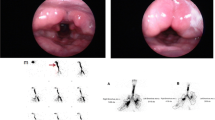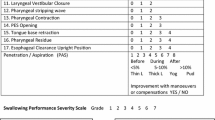Abstract
The purposes of this study were to (1) evaluate swallowing function using both subjective and objective measures in patients treated nonsurgically for stages III and IV laryngeal squamous cell carcinoma, (2) assess the effect of time from treatment completion on swallowing function, and (3) assess sequelae associated with modality of treatment. To achieve these objectives, a retrospective study of 14 patients was conducted. Fiberoptic endoscopic evaluation of swallowing (FEES) was performed and evaluated by three independent judges for seven functional criteria: standing secretions, valleculae spillage, valleculae residue, postcricoid residue, laryngeal penetration, aspiration, and cough. Patient interviews were performed to establish patient perception of swallowing and his/her current posttreatment diet. Results revealed that each patient exhibited swallowing abnormalities in at least one of the seven objective functional categories studied. Ten patients suffered from variable degrees of dysphagia, ranging from mild to severe, on all measures. No significant differences were noted between those patients with less than or greater than 12 months posttreatment. Common treatment sequelae included PEG tube placement for nutritional supplementation, tracheostomy placement for airway security and/or pulmonary toilet, repeated episodes of aspiration pneumonia requiring hospital admission, and radiation-induced oropharyngeal stricture. Further studies using subjective and objective swallowing function measures for patients treated with alternative chemoradiation regimens versus surgery (with or without adjuvant therapies) for advanced stage laryngeal cancer are needed.

Similar content being viewed by others
References
Stenson KM, MacCracken E, List M, Haraf DJ, Brockstein B, Weihselbaum R, et al.: Swallowing function in patients with head and neck cancer prior to treatment. Arch Otolaryngol Head Neck Surg 126:371–377, 2000
Logemann JA, Bytell DE: Swallowing disorders in three types of head and neck surgical patients. Cancer 44(3):1095–1105, 1979
Logemann JA: Aspiration in head and neck surgical patients. Ann Otol Rhinol Laryngol 94(4 Pt 1):373–376, 1985
Taylor SG, Murthy AK, Griem KL, Recine DC, Kiel K, Blendowski C, et al.: Concomitant cisplatin/5-FU infusion and radiotherapy in advanced head and neck cancer: 8-year analysis of results. Head Neck 9:684–691, 1997
Newman LA, Vieira F, Schwiezer V, Sammant S, Murry T, Woodson G, et al.: Eating and weight changes following chemoradiation for advanced head and neck cancer. Arch Otolaryngol Head Neck Surg 124:589–592, 1998
McConnel FM, Pauloski BR, Logemann JA, Rademaker AW, Colangelo L, Shedd D, et al.: Functional results of primary closure vs. flaps in oropharyngeal reconstruction. Arch Otolaryngol Head Neck Surg 124:625–630, 1998
Kotz T, Abraham S, Beitler JJ, Wadler S, Smith RV: Pharyngeal transport dysfunction consequent to an organ-sparing protocol. Arch Otolaryngol Head Neck Surg 125:410–413, 1999
Smith RV, Kotz T, Beitler JJ, Wadler S: Long-term swallowing problems after organ preservation therapy with concomitant radiation therapy and intravenous hydroxyurea. Arch Otolaryngol Head Neck Surg 126:384–389, 2000
Zacharek M, Meleca RJ, Dworkin JP, Stachler RJ, Jacobs JR, Marks SC, et al.: Functional outcomes after supracricoid laryngectomy. Laryngoscope 111:1558–1564, 2001
Weinstein GS, El-Sawy MM, Ruiz C, Dooley P, Chalian A, El-Sayed MM, et al.: Laryngeal preservation with supracricoid partial laryngectomy results in improved quality of life when compared with total laryngectomy. Laryngoscope 111:191–199, 2001
Blalock D: Speech rehabilitation after treatment of laryngeal carcinoma. Otolaryngol Clin North Am 30(2):179–188, 1997
Suits GW, Cohen JI, Everts EC: Near-total laryngectomy patient selection and technical considerations. Arch Otolaryngol Head Neck Surg 122:473–475, 1996
Hirano M, Kuroiwa Y, Tanaka S, Matsuoka H, Sato K, Yoshida T: Dysphagia following various degrees of surgical resection for oral cancer. Ann Otol Rhinol Laryngol 101(2 Pt 1):138–141, 1992
Sessions DG, Zill R, Schwart SL: Deglutition after conservation surgery for cancer of the larynx and hypopharynx. Otolaryngol Head Neck Surg 87(6):779–796, 1979
Conley J: Swallowing dysfunctions associated with radical surgery of the head and neck. Arch Surg 80:602–612, 1960
Litton WB, Leonard JR: Aspiration after partial laryngectomy: cineradiographic studies. Laryngoscope 79(5):887–908, 1969
Ekberg O, Nylander G: Pharyngeal dysfunction after treatment for pharyngeal cancer with surgery and radiotherapy. Gastrointest Radiol 8:97–104, 1983
Pauloski BR, Rademaker AW, Logemann JA, Colangelo LA: Speech and swallowing in irradiated and nonirradiated postsurgical oral cancer patients. Otolaryngol Head Neck Surg 118:616–624, 1998
Hirsch SM, Caldarelli DD, Hutchinson JC Jr, Holinger LD, Murthy AK, et al.: Concomitant chemotherapy and split-course radiation for cure and preservation of speech and swallowing in head and neck cancer. Laryngoscope 101:583–586, 1991
Koch WM, Lee DJ, Eisele DW, Miller D, Poole M, Cummings CW, et al.: Chemoradiotherapy for organ preservation in oral and pharyngeal carcinoma. Arch Otolaryngol Head Neck Surg 121(9):974–980, 1995
Murry T, Madasu R, Martin A, Robbins KT: Acute and chronic changes in swallowing and quality of life following intraarterial chemoradiation for organ preservation in patients with advanced head and neck cancer. Head Neck 20:31–37, 1998
List MA, Siston A, Haraf D, Schumm P, Kies M, Stenson K, et al.: Quality of life and performance in advanced head and neck cancer patients on concomitant chemoradiotherapy: a prospective examination. J Clin Oncol 17:1020–1028, 1999
Logemann J: Mechanisms of normal and abnormal swallowing. In: Cummings CW, Fredrickson JM, Harker LA, et al. (eds.) Otolaryngology-Head and Neck Surgery, Vol. 3. St. Louis: Mosby, 1998, pp 1844–1853
Hamlet S, Faull J, Klein B, Aref A, Fontanesi J, Stachler R, et al.: Mastication and swallowing in patients with postirradiation xerostomia. Int J Radiat Oncol Biol Phys 37:789–796, 1997
Eisele DW, Koch DG, Tarazi AE, Jones B: Aspiration from delayed radiation fibrosis of the neck. Dysphagia 6(2):120–122, 1991
Graeff A, Leeuw R, Ros W, Hordijk GJ, Battermann JJ, Blijham GH, et al.: A prospective study of life of laryngeal cancer patients treated with radiotherapy. Head Neck 21:291–296, 1999
Hillman RE, Walsh MJ, Wolf GT, Fischer SG, Hong WK: Functional outcomes following treatment for advanced laryngeal cancer. Part I – Voice preservation in advanced laryngeal cancer. Part II – Laryngectomy rehabilitation: the state of the art in the VA system. Arch Otolaryngol Head and Neck Surg 107(Suppl 172):1–28, 1998
Terrell JE, Fisher SG, Wolf GT: Long term quality of life after treatment of laryngeal cancer. Arch Otolaryngol Head Neck Surg 124:964–971, 1998
Lazarus CL, Logemann JA, Pauloski BR, Colangelo LA, Kahrilas PJ, Mittal BB, et al.: Disorders in head and neck cancer patients treated with radiotherapy and adjuvant chemotherapy. Laryngoscope 106(9 Pt 1):1157–1166, 1996
Hammerlid E, Bjordal K, Ahlner-Elmqvist M, Jannert M, Kaasa S, Sullivan M, et al.: Prospective, longitudinal quality-or-life study of patients with head and neck cancer: a feasibility study including the EORTC QLC-C30. Otolaryngol Head Neck Surg 116:666–673, 1997
Aviv JE, Kim T, Sacco RL, Kaplan S, Goodhart K, Diamond B, et al.: FEESST: a new bedside endoscopic test of the motor and sensory components of swallowing. Ann Otol Rhinol Laryngol 107(5 Pt 1):378–387, 1998
Aviv JE, Spitzer J, Cohen M, Ma G, Belafsky P, Close LG: Laryngeal adductor reflex and pharyngeal squeeze as predictors of laryngeal penetration and aspiration. Laryngoscope 112(2):338–341, 2002
Langmore SE: Issues in the management of dysphagia. Folia Phoniatr Logop 51(4–5):220–230, 1999
Author information
Authors and Affiliations
Corresponding author
Rights and permissions
About this article
Cite this article
Dworkin, J.P., Hill, S.L., Stachler, R.J. et al. Swallowing Function Outcomes Following Nonsurgical Therapy for Advanced-Stage Laryngeal Carcinoma. Dysphagia 21, 66–74 (2006). https://doi.org/10.1007/s00455-005-9001-8
Published:
Issue Date:
DOI: https://doi.org/10.1007/s00455-005-9001-8




